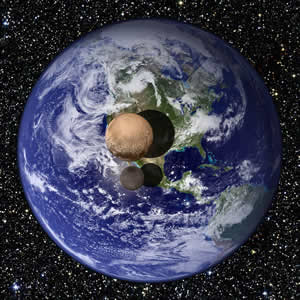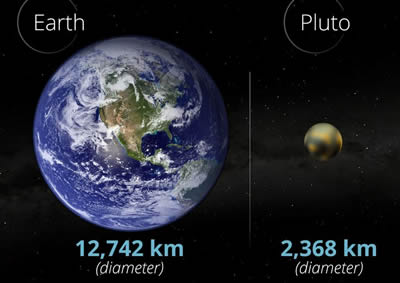Difference between Earth and Pluto
Key Difference: Earth is the third planet in our solar system. It is the planet that humans live on as well as other forms of life. Pluto is a dwarf planet within the solar system. It is located beyond Neptune, in the Kuiper belt.
 Earth and Pluto are two planets in our solar system, well they were once considered to be in any case. Growing up, every kid knew that there were nine planets in the solar system: Mercury, Venus, Earth, Mars, Jupiter, Saturn, Uranus, Neptune, and Pluto. However, that is not what the newer generations are being taught today. For them, there are only eight planets in the solar system.
Earth and Pluto are two planets in our solar system, well they were once considered to be in any case. Growing up, every kid knew that there were nine planets in the solar system: Mercury, Venus, Earth, Mars, Jupiter, Saturn, Uranus, Neptune, and Pluto. However, that is not what the newer generations are being taught today. For them, there are only eight planets in the solar system.
In 2006, Pluto had been demoted to being a dwarf planet. The reason for that is because it is quite small. In fact, it is smaller than seven of the moons in our solar system, including Earth’s Moon. Visually, it is only half the size of the United States of America, yet it is the largest dwarf planet in our solar system. However, largest does not equate to most massive, as it is only the second most massive, with Eris being the most massive.
Earth is the third planet in the solar system. It is also the densest planet in the solar system and the largest of the four terrestrial planets, which also include Mars, Venus, and Mercury. It is covered in water and has a robust atmosphere. It is also the only known object in the universe that has the capacity of life. Earth’s surface is 29% land and 71% water.
In comparison, Pluto’s surface is covered two-thirds by rock, and one-third by water. In fact, at times the dwarf planet also has an atmosphere and it rains. When Pluto is closest to the Sun during its orbit, the ice on its surface thaws and forms a thin atmosphere mainly of nitrogen. It also contains a thin methane haze about 161 kilometers above the surface. When this haze is hit by sunlight, the molecules get converted into hydrocarbons that fall to the ground and coat the ice with a dark covering. As Pluto travels away from the Sun, this temporary atmosphere then freezes back to its solid state.
 Additionally, the Earth has only one moon, named Moon or less commonly Luna, whereas Pluto has 5: Charon (the largest), Hydra, Nix, Kerberos, and Styx. Also, Pluto is only about 18.5% the size of Earth and its orbit lasts 248 years, whereas earth’s orbit is 365.26 days. Pluto’s orbit is also on tilted, whereas Earth’s is not. Earth’s orbit is elliptical with the sun in the center and Pluto’s orbit is oval shaped and does not have the sun in its center. Pluto is also located much farther from the Sun, then the Earth; which is why it is mostly frozen, unlike Earth.
Additionally, the Earth has only one moon, named Moon or less commonly Luna, whereas Pluto has 5: Charon (the largest), Hydra, Nix, Kerberos, and Styx. Also, Pluto is only about 18.5% the size of Earth and its orbit lasts 248 years, whereas earth’s orbit is 365.26 days. Pluto’s orbit is also on tilted, whereas Earth’s is not. Earth’s orbit is elliptical with the sun in the center and Pluto’s orbit is oval shaped and does not have the sun in its center. Pluto is also located much farther from the Sun, then the Earth; which is why it is mostly frozen, unlike Earth.
Comparison between Earth and Pluto:
|
|
Earth |
Pluto |
|
Designation |
Planet |
Dwarf Planet |
|
Discovery |
Not discovered but considered as one of the planets of the solar system by the 16th century primarily due the studies of Copernicus |
Discovered on February 18th 1930, by Clyde W. Tombaugh |
|
Name |
Derived from Old English and Germanic root word, eorðe meaning soil and ground. |
Named after the Roman god of the Underworld, Pluto |
|
Location |
Third planet from the Sun |
Located in the Kuiper belt, a ring of bodies beyond Neptune |
|
Size |
Equatorial Diameter: 12,756 km |
Diameter: 2,372 km |
|
Mass |
5.97237×1024 kg (1.31668×1025 lb) |
(1.303±0.003)×1022 kg 0.17 Moons |
|
Surface Temperature |
-88 to 58°C |
-229°C |
|
Orbit |
Elliptical, with the sun in the center |
Oval shaped orbit and the sun is not in then center. The orbit is also tilted unlike any of the planet orbits. |
|
Orbit Period |
365.26 days |
248.0 years |
|
Moons |
Earth has one moon, aptly named Moon |
Pluto has 5 moons, Charon (biggest and discovered in 1978), Hydra and Nix (both discovered in 2005), Kerberos originally P4 (discovered 2011) and Styx originally P5 (discovered 2012). |
|
Life |
Life and vegetation exists. |
No life and vegetation, as far as we know yet. |
|
Water |
71% of Earth's surface is covered with water |
One third of Pluto’s surface is covered in ice, which accounts to three times as much water as on Earth. |
|
Surface |
29% of Earth's surface is land mass, consisting of continents and islands. |
Two thirds of the surface is rock, which has several mountain ranges, light and dark regions, and a scattering of craters. |
|
Atmosphere |
Earth has an atmosphere, primarily composed of nitrogen, oxygen, carbon dioxide, etc. This is what allows us to breathe. |
Has a temporary atmosphere that forms as the dwarf planet gets closer to the sun. The ice melts and forms the atmosphere, which freezes again to its natural state when Pluto moves away from the sun again. |
Reference: Wikipedia (Earth and Pluto), NASA, Space Facts Image Courtesy: time.com, pinterest.com









Comments
amy
Tue, 02/28/2017 - 08:09
Add new comment